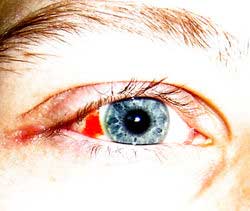Do not underestimate blurry or red eyes; you might be suffering from one of the five most common eye diseases.
1- Myopia
Diagnosis:
 |
|
Red Eyes (Image: Wikimedia) |
Myopia occurs when you cannot see distant objects clearly. The exact cause is unclear, but it may be due to overexertion of the eyes.
At-risk individuals: Your chances of developing this condition are higher if either of your parents is myopic.
Solutions: Wear glasses or contact lenses. It can also be permanently corrected through laser surgery, although this is effective only for certain individuals. Additionally, the NeuroVision method—a series of computer-based interactive exercises—can help reduce myopia levels.
2- Retinal Diseases
Diagnosis: Two particularly serious retinal problems are retinal detachment and diabetic retinopathy. When the retina detaches from the outer layers of the eye, vision can gradually weaken or be completely lost.
The cause of retinal detachment is usually fluid entering the holes or tears in the retina, separating it from the underlying layers. Symptoms include swollen dark spots and flashes of light.
If you see dark shadows, experience blurred vision, or go completely blind, it is a critical situation. Diabetic retinopathy results from diabetes damaging the tiny blood vessels in the retina, potentially leading to blindness.
At-risk individuals: Women who have had cataract surgery, individuals with a family history of retinal disease, and women with severe myopia are at higher risk for retinal detachment. Diabetic retinopathy can only occur in individuals with diabetes.
Solutions: Treatment for retinal detachment may include surgery, cryotherapy, or laser photocoagulation. Laser photocoagulation and vitrectomy surgery are commonly used to treat diabetic retinopathy.
3- Glaucoma
Diagnosis: This condition typically occurs when there is an increase in fluid pressure within the eyeball, damaging the optic nerve and potentially leading to blindness. The primary cause is an imbalance between the production and drainage of fluid in the eye.
There are 2 types of glaucoma: Open-angle and angle-closure. Open-angle glaucoma often has no symptoms until the disease reaches an advanced stage. In contrast, individuals with angle-closure glaucoma may experience eye pain, redness, headaches, nausea, vomiting, and see halos around lights.
At-risk individuals: Middle-aged and elderly individuals.
Solutions: Eye drops or oral medications, surgery, or laser treatment may be necessary.
4- Cataracts
Diagnosis: This occurs when the eye’s lens becomes cloudy, preventing adequate light from entering the eye and thus affecting vision. It is often a result of aging, prolonged exposure to ultraviolet rays, long-term medication use, or other diseases.
The most basic symptom is blurred vision that cannot be improved, even with glasses or increased prescription strength.
At-risk individuals: Typically, women over the age of 55 are more prone to this condition, though younger individuals should not be complacent.
Solutions: Phacoemulsification surgery can provide a permanent cure.
5- Thyroid Eye Disease
Diagnosis: Thyroid Eye Disease (TED) is an eye condition caused by the thyroid gland, which regulates the body’s metabolism. Patients with TED often experience dizziness, bulging eyes, swollen eyelids, and blurred vision or double vision. Sometimes, red eyes, tearing, and a sandy sensation in the eyes can occur.
At-risk individuals: Women are more likely to be affected than men.
Solutions: Surgery may be performed to relieve pressure and reduce bulging of the eyeball. Surgery may also be necessary to correct misalignment and reduce swelling.
When to See an Eye Doctor?
Glaucoma: Women aged 40 or over are at high risk and should have regular eye check-ups, especially if there is a family history of glaucoma.
Cataracts: If you have been on long-term steroid treatment and your vision is blurry that cannot be corrected with glasses.
Myopia: Eye exams should be conducted at least once a year.
Thyroid Eye Disease: You should have your eyes checked if you have thyroid disease.
Retinal Diseases: Regular eye examinations are crucial if you have myopia or diabetes.
Eye Care Tips
– Have regular eye exams. Early detection can lead to the successful treatment of eye diseases. When outdoors, wear sunglasses to protect your eyes from UV rays and prevent cataracts.
– Always read books and newspapers in good lighting to avoid straining your eyes. After every half hour of intense eye work, take a break by looking away or focusing on distant objects.


















































